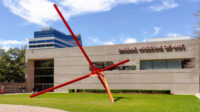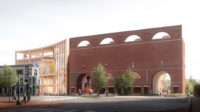Dallas Museum of Art Unveils Finalist Design Concepts for Reimagined Campus
-North-Harwood-Street-View--Michael-Maltzan-Architecture-and-MRC-min.jpg?1689196942)
North Harwood Street view of the Dallas Museum of Art, as envisioned by Michael Maltzan Architecture. The firm leads one of six shortlisted teams vying to be selected for a major campus overhaul. Image © Michael Maltzan Architecture and Malcolm Reading Consultants
Architects & Firms
The Dallas Museum of Art (DMA) has released six design concepts produced by an international cohort of shortlisted teams selected to dramatically reimagine the campus of the venerable Texas institution, which opened at its current Edward Larrabee Barnes–designed home in 1984 in the city’s Arts District. (Established in 1903, the DMA was previously located in Fair Park.)
The shortlist, announced in April as part of the two-stage competition organized by Malcolm Reading Consultants, is led by the following firms, none of them Texas-based but all heavyweights in the realm of high-profile museum and cultural commissions: David Chipperfield Architects (London), Diller Scofidio + Renfro (New York), Johnston Marklee (Los Angeles), Michael Maltzan Architecture (L.A.), Nieto Sobejano Arquitectos (Madrid), and Weiss/Manfredi (New York). Per the competition brief, the finalists were tasked with “giving the campus greater physical visibility and transparency, showing visitors what is going on inside, and making the DMA more welcoming, and accessible to all.” As elaborated by the museum, the expansion project “focuses on strengthening the DMA’s work with its communities, creating stronger civic connections, transforming the welcome for visitors with new facilities, and expanding education and gallery space to accommodate important collections—all underpinned by a thorough modernization.”
“These initial designs from some of the world’s most in-demand creative minds help us visualize how the DMA could reinvent itself, and they’ve thrilled us,” said Architect Selection co-chairs Jennifer Eagle and Lucilo Peña in a statement. “Yet among the six there is only one winner . . . so we’re aware we are approaching a momentous decision in the lifetime of this Museum.”
Each of the six finalist designs are now available for in-person public viewing—and feedback—at a free exhibition held at the DMA as well as virtually via an online gallery hosted by Malcolm Reading Consultants. This month, the Architect Selection Committee will meet with each of the six shortlisted teams for interviews before making their final recommendation to the Dallas Museum of Art Board of Trustees. A winning team is anticipated to be announced in August, at which point the design concept will be developed in partnership with the DMA and its stakeholders, according to a press release.
Below are brief descriptions of the finalist designs as provided by the teams, accompanied by a list of partnering firms.
David Chipperfield Architects
HarrisonKornberg Architects (local architect); James Corner Field Operations (landscape architect); Pentagram (exhibition design); Thornton Tomasetti (structural engineer); Arup (services and lighting); and Atelier Ten (sustainability)
-Flora-Street-Courtyard--David-Chipperfield-Architects-and-MRC.webp) 1
1
-Gallery-View--David-Chipperfield-Architects-and-MRC.webp) 2
2
Flora Street Courtyard (1); gallery view (2). Images © David Chipperfield Architects and Malcolm Reading Consultants
Our design concept originates from a profound sense of respect for the existing DMA campus and a desire to deepen its engagement with the energetic qualities of its immediate urban surroundings. An interpretation of the Museum’s most successful qualities has formed the basis of our approach to reimagining a new DMA that is both culturally and socially responsive, and ecologically responsible.
A bold revitalization of the Museum’s external public spaces, from the DMA’s doorstep to its rooftop, creates a stepped landscape that invites visitors to explore and rest, and to encounter artworks, performances, and public events. Inside the Museum, our interventions dramatically transform the DMA’s underwhelming central circulation spaces to create a dynamic and flexible curatorial Street, which is conceived as a seamless continuation of Klyde Warren Park, the Dallas Arts District, and Downtown.
Inside and out, the new DMA is transformed into a vital and accessible topography for the city that expresses and reinforces its cultural, civic, and community value for the people of Dallas.
Diller Scofidio + Renfro
Michael Van Valkenburgh Associates Inc. (landscape architect); Arup (MEP, sustainability, and daylighting engineer); LERA Consulting Structural Engineers (structural engineer); New Affiliates (exhibition design); and GFF (local architect)
-Lobby-from-Auditorium--Diller-Scofidio--Renfro-and-MRC-copy-copy.webp) 3
3
-Aerial-from-Klyde-Warren-Park--Diller-Scofidio--Renfro-and-MRC.webp) 4
4
Lobby view from auditorium (3); aerial from Klyde Warren Park (4). Images © Diller Scofidio + Renfro and Malcolm Reading Consultants
Edward Larrabee Barnes’s 1984 DMA reflects the values of its time—aloof and sequestered from the everyday lives of Dallas citizens. The new expansion will embrace the public. It will allow the DMA to show its growing collection in new ways, reaching across diverse audiences. It will engage the open sites to the north and south to create two new front doors that bookend the Museum, each visually porous and bustling with activity.
Facing Klyde Warren Park, a new contemporary gallery will cap a civic hub where the lobby, lecture hall, theater, education space, store, and café converge. This new face of the DMA will be fully visible from the park and the approach up Woodall Rodgers. To the south, a new restaurant and event pavilion will suspend an operable roof that will shade and provide infrastructural support for open-air public programming, while connecting with the Arts District at large.
Johnston Marklee
Christ & Gantenbein (museum specialists); MOS Architects (public realm); Sam Jacob Studio (exhibition design); Hargreaves Jones (landscape architect); Buro Happold (MEP and sustainability engineer); Walter P. Moore with Martinez Moore Engineers (structural engineer); and Kendall/Heaton Associates (local architect)
-Contemporary-Galleries-Pavilion--Johnston-Marklee-and-MRC.webp) 5
5
-New-Interior-Street--Johnston-Marklee-and-MRC.webp) 6
6
Contemporary Galleries Pavilion (5); new interior street (6). Images © Johnston Marklee and Malcolm Reading Consultants
Our vision for the DMA is of a museum in a garden. A collection of pavilions and courtyards both existing and new, linked by a lively internal street. A place that welcomes and engages its visitors: where art connects with nature, and culture connects with the city.
A museum that is made up of collectives and collections, whose architecture forges connections and dialogues among objects, spaces, and people, between city and museum, between art and life, between old and new.
The new pavilions provide contemporary gallery and event spaces in volumes referring back to the DNA of the DMA. Their vaulted profiles project the Museum’s image outwards, articulating the welcoming porosity between city, street, museum circulation, galleries, and gardens. Their materiality articulates a contrasting sensibility: ethereal and light, whose translucency reveals the Museum’s workings to the city beyond.
Michael Maltzan Architecture
Studio Zewde (landscape architect); Guy Nordenson and Associates (structural design engineer); Buro Happold (MEP engineer); Atelier Ten (sustainability); and JSA/MIXdesign (exhibition design and accessibility)
-Concourse-View--Michael-Maltzan-Architecture-and-MRC.webp) 7
7
-Ross-Avenue-View--Michael-Maltzan-Architecture-and-MRC-copy.webp) 8
8
Concourse view (7); Ross Avenue view (8). Images © Michael Maltzan Architecture and Malcolm Reading Consultants
We believe that the architecture and landscape of the reimagined DMA can weave together the history and the future of both the Museum and Dallas. At the core of our architectural response, we seek to preserve the philosophical aspirations of the original Edward Larrabee Barnes design, modifying it to support the DMA’s evolving requirements.
Its stepped gallery sequence is woven together with a new “superfloor” of gallery and program spaces that float above the treetops of the Arts District. Elevating the galleries enables the transformation of North Harwood Street into a “cultural carpet,” an animated civic landscape that bridges Klyde Warren Park and Downtown. We transform the original inward-looking concourse into a new transparent facade that reveals the vibrant activity of the DMA. Collectively, these changes create a new image of the DMA, one that is open, forward-looking, and reflective of the Museum’s role in the coming century.
Nieto Sobejano Arquitectos
Atelier Culbert (exhibition design); SWA Group (landscape architect); Arup (MEP, lighting, and sustainability engineer); Bollinger+Grohmann (structural and facade engineer); and PGAL (local architect)
-View-from-Klyde-Warren-Park--Nieto-Sobejano-Arquitectos-and-MRC.webp) 9
9
-Rooftop-Gallery-View--Nieto-Sobejano-Arquitectos-and-MRC-(1).webp) 10
10
View from Klyde Warren Park (9); rooftop gallery view (10). Images © Nieto Sobejano Arquitectos and Malcolm Reading Consultants
Art inspires the beginning of the architectural project to reimagine the DMA. Claude Monet’s The Water Lily Pond (1903) poetically suggests the reversal of reality in the reflection of water; the lightness of air and clouds versus rootedness in earth and vegetation.
Our proposal acknowledges the presence of the original building and its pivotal role in the development of the Dallas Arts District while proposing significant spatial architectural transformations respectful of its recent history.
The clear architectural scheme by Edward Larrabee Barnes, once conceived as an opaque and compact building, has been overtaken after four decades by the development and implementation of new settings in the Arts District. We propose an open, welcoming, accessible, and inclusive museum, improving and adding new spaces for contemporary art collections.
The reimagined DMA will be a reflection of the original building, transforming the relationship between art, landscape, and community into a balance of memory and innovation.
Weiss/Manfredi
Hood Design Studio (landscape architect); WeShouldDoItAll (exhibition design); DVDL (cultural strategists); Thornton Tomasetti (structural engineer); Jaros, Baum & Bolles (MEP/FP engineer); and Atelier Ten (sustainability)
-North-Entry-Plaza--WeissManfredi-and-MRC.webp) 11
11
-Gallery-View--WeissManfredi-and-MRC.webp) 12
12
North entry plaza (11); gallery view (12). Images © Weiss/Manfredi and Malcolm Reading Consultants
The Dallas Museum of Art is an enduring cultural wonder within the increasingly vibrant Dallas Arts District. We admire the cadence of architecture and landscape central to Edward Larrabee Barnes’s and Dan Kiley’s initial vision, yet the existing building’s opacity and unintuitive orientation conceal the vibrancy of this cultural campus. Our design activates and intensifies reciprocities—architecture and landscape, building and garden, art and community—to construct a new tapestry for the arts.
Through strategic subtraction and luminous additions, our design reinvigorates this elegant but fortified structure to signal a new transparency, both literal and philosophical, that welcomes the entire community. New galleries and gathering spaces, with generous ceilings and filtered natural light, and gardens to the north and south, anchor the urban edges. The visitor sequence culminates in a cantilevered gallery and roof garden overlooking Klyde Warren Park, bringing into focus the DMA’s role as an inspiring and welcoming catalyst to the cultural life of the city.



-Hamon-Forecourt-View--Nieto-Sobejano-Arquitectos.jpg?height=200&t=1691218537&width=200)
